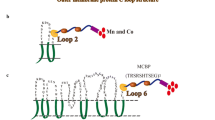Abstract
Monkey metallothionein α domain tandem repeats (4mMTα), which exhibit high cadmium affinity, have been displayed for the first time on the surface of a bacterium using ice nucleation protein N-domain (inaXN) protein from the Xanthomonas campestris pv (ACCC—10049) as an anchoring motif. The shuttle vector pIME, which codes for INAXN–4mMTα–EGFP fusion, was constructed and used to target 4mMTα and EGFP on the surface of Pseudomonas putida X4 (CCTCC—209319). The surface location of the INAXN–4mMTα–EGFP fusion was further verified by western blot analysis and immunofluorescence microscopy. The growth of X4 showed resistance to cadmium presence. The presence of surface-exposed 4mMTα on the engineered strains was four times higher than that of the wild-type X4. The Cd2+ accumulation by X4/pIME was not only four times greater than that of the original host bacterial cells but was also remarkably unaffected by the presence of Cu2+ and Zn2+. Moreover, the surface-engineered strains could effectively bind Cd2+ under a wide range of pH levels, from 4 to 7. P. putida X4/pIME with surface-expressed 4mMTα–EGFP had twice the cadmium binding capacity as well as 1.4 times the fluorescence as the cytoplasmic 4mMTa–EGFP. These results suggest that P. putida X4 expressing 4mMTα–EGFP with the INAXN anchor motif on the surface would be a useful tool for the remediation and biodetection of environmental cadmium contaminants.







Similar content being viewed by others
References
Bae W, Chen W, Mulchandani A, Mehra RK (2000) Enhanced bioaccumulation of heavy metals by bacterial cells displaying synthetic phytochelatins. Biotechnol Bioeng 70(5):518–524
Bae W, Wu CH, Kostal J, Mulchandani A, Chen W (2003) Enhanced mercury biosorption by bacterial cells with surface-displayed MerR. Appl Environ Microbiol 69(6):3176–3180
Bontidean I, Berggren C, Johansson G, Csoregi E, Mattiasson B, Lloyd JR, Jakeman KJ, Brown NL (1998) Detection of heavy metal ions at femtomolar levels using protein-based biosensors. Anal Chem 70(19):4162–4169
Capdevila M, Cols N, Romero-Isart N, Gonzalez-Duarte R, Atrian S, Gonzalez-Duarte P (1997) Recombinant synthesis of mouse Zn3-beta and Zn4-alpha metallothionein 1 domains and characterization of their cadmium(II) binding capacity. Cell Mol Life Sci 53(8):681–688
Chalfie M, Tu Y, Euskirchen G, Ward WW, Prasher DC (1994) Green fluorescent protein as a marker for gene expression. Science 263(5148):802–805
Cormack BP, Valdivia RH, Falkow S (1996) FACS-optimized mutants of the green fluorescent protein (GFP). Gene 173(1 Spec No):33–38
Deng X, Yi XE, Liu G (2007) Cadmium removal from aqueous solution by gene-modified Escherichia coli JM109. J Hazard Mater 139(2):340–344
Fu YJ, Chen WL, Huang QY (2008) Construction of two lux-tagged Hg2+-specific biosensors and their luminescence performance. Appl Microbiol Biotechnol 79(3):363–370
Holan ZR, Volesky B, Prasetyo I (1993) Biosorption of cadmium by biomass of marine algae. Biotechnol Bioeng 41(8):819–825
Huang ZX, Gao Y, Yu WH, Zhang SY, Yang PY (2002) Construction of alpha-alpha domains structure in recombinant monkey metallothionein-1. J Inorg Biochem 92(3–4):183–192
Kotrba P, Doleckova L, de Lorenzo V, Ruml T (1999) Enhanced bioaccumulation of heavy metal ions by bacterial cells due to surface display of short metal binding peptides. Appl Environ Microbiol 65(3):1092–1098
Kurasaki M, Yamaguchi R, Linde Arias AR, Okabe M, Kojima Y (1997) Significance of alpha-fragment of metallothionein in cadmium binding. Protein Eng 10(4):413–416
Kuroda K, Ueda M (2006) Effective display of metallothionein tandem repeats on the bioadsorption of cadmium ion. Appl Microbiol Biotechnol 70(4):458–463
Laddaga RA, Silver S (1985) Cadmium uptake in Escherichia coli K-12. J Bacteriol 162(3):1100–1105
Lu YD, Huang QY, Chen WL (2008) Construction and expression of metallothionein mutations and the heavy-metal adsorption capacity of the engineered bacteria. Acta Sci Circumst 28(9):1763–1770
Ma Y, Lin J, Zhang C, Ren Y (2011) Cd(II) and As(III) bioaccumulation by recombinant Escherichia coli expressing oligomeric human metallothioneins. J Hazard Mater 185(2–3):1605–1608
Murooka Y, Nagaoka T (1987) Expression of cloned monkey metallothionein in Escherichia coli. Appl Environ Microbiol 53(1):204–207
Nielson KB, Winge DR (1984) Preferential binding of copper to the beta domain of metallothionein. J Biol Chem 259(8):4941–4946
Nriagu JO, Pacyna JM (1988) Quantitative assessment of worldwide contamination of air, water and soils by trace metals. Nature 333(6169):134–139
Ozdemir G, Ceyhan N, Ozturk T, Akirmak F, Cosar T (2004) Biosorption of chromium(VI), cadmium(II) and copper(II) by Pantoea sp. TEM18. Chem Eng J 102(3):249–253
Shi H, Wen Su W (2001) Display of green fluorescent protein on Escherichia coli cell surface. Enzyme Microb Technol 28(1):25–34
Sousa C, Cebolla A, de Lorenzo V (1996) Enhanced metalloadsorption of bacterial cells displaying poly-His peptides. Nat Biotechnol 14(8):1017–1020
Tynecka Z, Gos Z, Zajac J (1981) Energy-dependent efflux of cadmium coded by a plasmid resistance determinant in Staphylococcus aureus. J Bacteriol 147(2):313–319
Winge DR, Miklossy KA (1982) Domain nature of metallothionein. J Biol Chem 257(7):3471–3476
Yang C, Zhao Q, Liu Z, Li Q, Qiao CL, Mulchandani A, Chen W (2008) Cell surface display of functional macromolecule fusions on Escherichia coli for development of an autofluorescent whole-cell biocatalyst. Environ Sci Technol 42(16):6105–6110
Yang F, Moss LG, Phillips GN Jr (1996) The molecular structure of green fluorescent protein. Nat Biotechnol 14(10):1246–1251
Acknowledgments
The research was financially supported by the Recommend International Advanced Agricultural Science & Technology Plan (“948” Program) and the National High Technology Research & Development Program of China (“863” Program, 2012AA100602).
Author information
Authors and Affiliations
Corresponding author
Electronic supplementary material
Below is the link to the electronic supplementary material.
ESM 1
(DOC 37 kb)
Rights and permissions
About this article
Cite this article
He, X., Chen, W. & Huang, Q. Surface display of monkey metallothionein α tandem repeats and EGFP fusion protein on Pseudomonas putida X4 for biosorption and detection of cadmium. Appl Microbiol Biotechnol 95, 1605–1613 (2012). https://doi.org/10.1007/s00253-011-3768-3
Received:
Revised:
Accepted:
Published:
Issue Date:
DOI: https://doi.org/10.1007/s00253-011-3768-3




